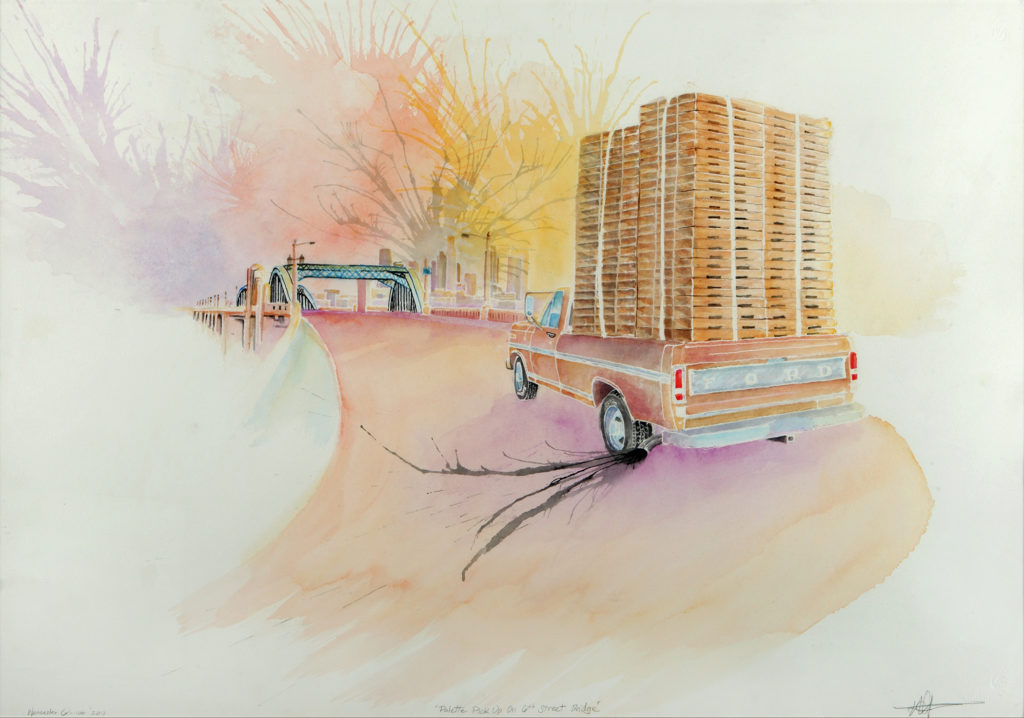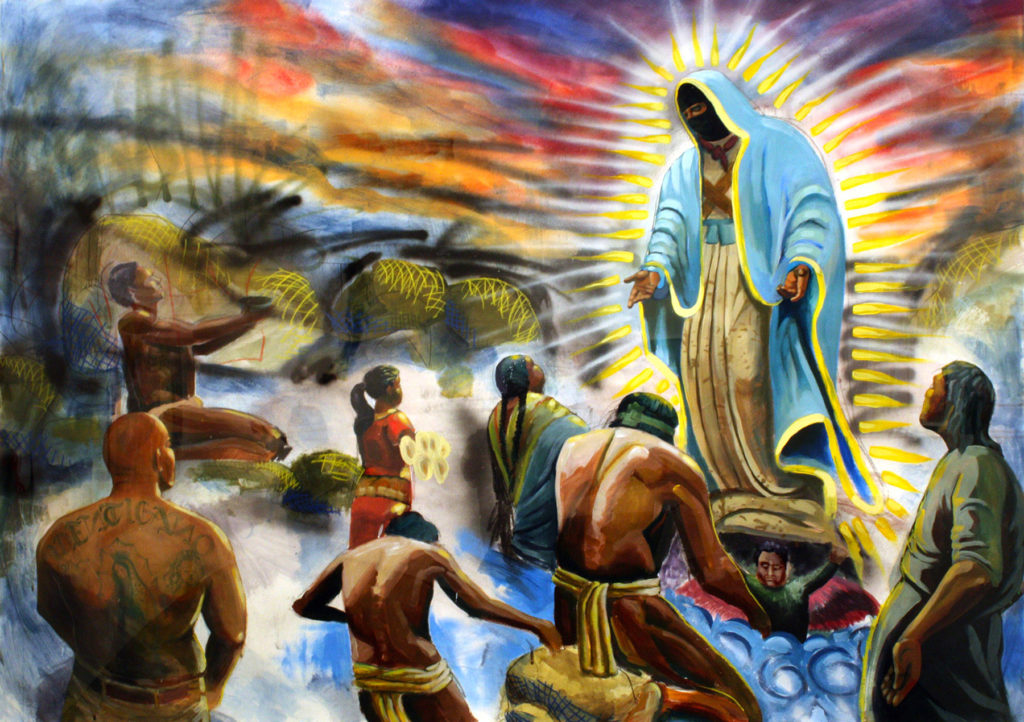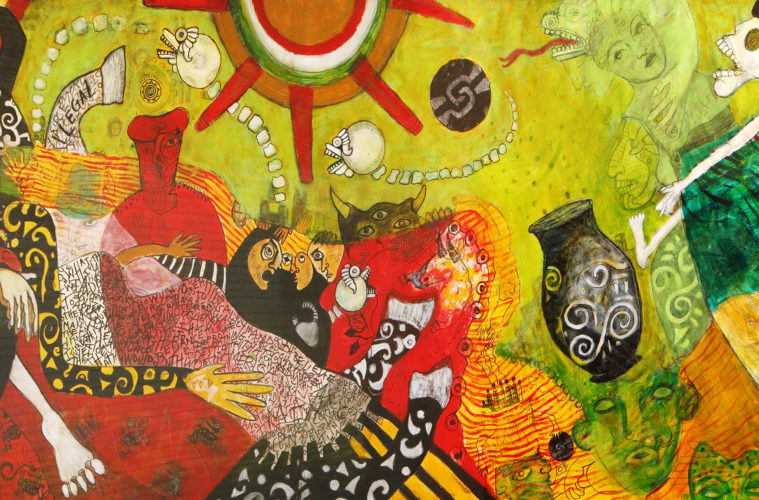Bright fauve-inspired colors, energetic brushstrokes and finely wrought figurative, abstract and surreal works characterize the striking exhibition “Papel Chicano Dos” at the Muzeo Museum and Cultural Center in Anaheim. The symbolism in many pieces harkens back to the 1960s Chicano civil rights movement in East L.A, called El Movimento, while the iconography in other works references Aztlán or the mythical ancestral home of the indigenous Aztec people.
The show is comprised of 64 artworks on paper, mostly paintings and drawings, by 24 artists — some well known, others emerging — with styles displaying a variety of influences, including classic European painting and Mexican muralism. The exhibition depicts art as activism, with many individual pieces portraying the Mexican-American community that the artists inhabit. Other works allude to the artists’ collective Central American ancestry.
Cheech Marin, the visionary collector and owner of these artworks, is known largely for his role in the marijuana-infused Cheech & Chong films of the 1970s and ‘80s. Yet art lovers from throughout the Southland have been admiring works from his 700-plus piece Chicano art collection, with many of these displayed over the last several years in museums and galleries, including the Museum of Latin American Art in Long Beach.
The Muzeo exhibition includes his watercolors, paintings in aquatint and pastel, and mixed media works. All of these will be included in “The Cheech Marin Center for Chicano Art, Culture,” to be housed in a 61,420-square-foot wing at the Riverside Art Museum, scheduled to open next year.

Frank Romero-Metro Station (Parade of Masks)
Among artists featured in the Muzeo exhibition is Carlos Almaraz, an original member of “Los Four,” an art collective that mounted the first Chicano art exhibition at UC Irvine in 1973. The artist’s pastel “Cat Man’s Wedding” (1985) is a wildly colored semi-abstract illustration of frolicking cats. His figurative “Southwest Song” (1988), depicting a horse and rider sauntering in a surreal landscape, combines ancient iconography with southwestern imagery. Almaraz’s 1989 serigraph, “Mystery in the Park,” is a luminous dark SoCal landscape with palm trees, buildings, water and boats.
Another original member of “Los Four” (which had its second showing at the Los Angles County Museum of Art in 1974) is Gilbert “Magu” Lujan. In a catalog of his work, published by UC Irvine in 2017, he is quoted as writing: “Most Chicanos are aware of our current new breed renaissance which has flowered many investigations, probes and introspection in most areas of our life patterns…As we affirm broad-based awareness of our cultural linkage to Mexico and our Indian forefathers, it is clear to all that the Chicano culture is a real and identifiable body.”
Luhan’s 1990 pastel painting in this exhibition, “Pete y Arty,” is a figurative portrait of a smiling young man, alongside his identifiable hybrid dog person, with a human body and dog head, which some “authorities” say is derived from images of Egyptian gods. His “Blue Dog and Piwi” (1990) includes similar characters, but the dog person in this piece is blue. His scene-stealer in this show is his brightly painted, nearly psychedelic 1967 Chevrolet sedan, with a passenger seat decorated to resemble a taco.
Two aquatint etchings by Roberto Gil De Montes, “Jaguar Man, yellow” and “Jaguar Man, red” (both, 1985) also feature hybrid dog people. Yet Montes’ characters are set in hazy surreal surroundings, rather than in SoCal landscapes.
Frank Romero’s (also a “Los Four” member) contribution to this show is his 1991 pastel diptych “Festival of Masks Parade,” featuring a variety of Mexican characters in traditional garb, several with masks. The second part of the diptych portrays instrument-playing marchers in uniforms.

Wenceslao Quiroz-Pallet Pickup on 6th Street Bridge (Courtesy of the artist)
Six paintings by Sonya Fe, titled “Retold Story of La Llorona” (2000), in mixed media chalk, ink, gesso and watercolor, is a visual depiction of the Mexican legend about an abandoned woman who in turn abandons her own children, and then descends into hell on earth. The final painting in this series illustrates the spiritually distraught woman wandering in the moonlight with her gaunt face looking toward the heavens, as tears flow endlessly from her eyes. The Muzeo staff explains that artist Fe was unable to look at this terrifying painting after she completed it.
Benito Huerta’s “Exile off Main Street” (2005) appropriates Picasso’s well-known cubist painting, “Les Demoiselles d’Avignon” of prostitutes in Barcelona. Yet Huerto’s pastel and watercolor piece is more menacing and visceral with sharp outlines and revealing body parts. John M. Valadez’s 2014 serigraphs “Clavo,” of a Chicano man staring at the viewer, and “Alice,” of a beautiful young Chicano, are detailed and photorealistic. And Wenceslao Quiroz’s watercolor, “Pallet Pickup on 6th Street Bridge” (2013) is a lush pastel landscape, with a pickup truck in the foreground and tall buildings in the distance.

Pablo Cristi-If La Virgin Came Back Today (Courtesy of the artist)
“Soy Chicana” (2013) by CiCi Segura Gonzalez contains a riot of female-oriented accessories, including bottles, draped material and jewelry, alongside skeletons and other menacing figures. The colors are bright reds, yellows and greens, punctuated by black. Even more dramatic is Pablo Cristi’s acrylic and spray paint “If La Virgen Came Back Today” (2014). The painting’s dark masked virgin, emerging from the ether, counsels several seeking, dark-skinned native people. With its ambiguous message, this painting could be profoundly religious or incredulous about the significance of the virgin’s appearance.
“Papel Chicano Dos” also features work by Carlos Donjuan (“Night Shift” series with blank faces); Cesar Martinez (watercolors of hip, young Chicano men); Margaret Garcia (“Moonlight Embrace,” 2004, of two lovers); Gronk (with several colorful abstract woodcut prints with graffiti style outlines); Raul Guerrero (the dark, brooding “Coco Club Tijuana,” 1990); Roberto Gutierrez (“Bag Lady,” 2003, with a bag lady hobbling down an East L.A. street); Adan Hernandez (“Vato Getting Hit by Car,” 2006, one of few works in this show featuring a lowrider car); and by several other contemporary artists.
With dramatic lighting and exotically painted walls as backdrops, this exhibition brings viewers to a world in which activism, community support and especially knowledge of the Chicano ancestral history become muses for expressive and often politically charged artworks.
Muzeo Museum and Cultural Center, Anaheim; Wed.-Sun., 10 a.m.-5 p.m., free. Papel Chicano Dos is on view through July 14; muzeo.org.
Advertising disclosure: We may receive compensation for some of the links in our stories. Thank you for supporting Irvine Weekly and our advertisers.

